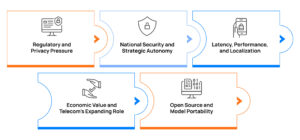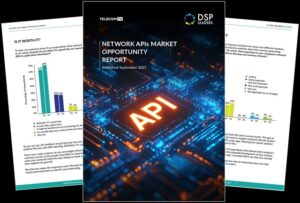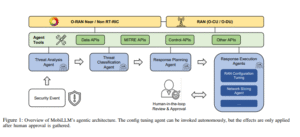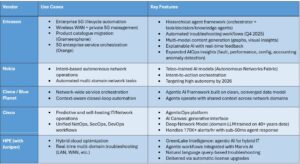In this blog, I explore a thought that struck me while delving into the transformer architecture behind large language models (LLMs). At the heart of this architecture lies the attention mechanism—a concept that has significantly shaped the capabilities of modern LLMs. I aim to reflect on how this same mechanism could potentially be applied to telecom networks to enhance security and drive intelligent optimization during critical scenarios. While there are certainly other approaches available, I wanted to present this as a conceptual idea worth considering.
Telecommunication networks are the backbone of our digital lives. Every message, video stream, phone call, or IoT signal flows through a complex mesh of infrastructure. Behind the scenes, these networks are producing vast volumes of data every second — from performance metrics and alarm logs to subscriber behavior and network configurations.
But with data growing exponentially, how can telecom operators distinguish the signal from the noise?
Traditional rule-based systems and static thresholds are beginning to show their age. As networks evolve — with 5G, edge computing, private networks, and AI-driven services — we need smarter, adaptive systems that can prioritize what’s important in real time. This is where the attention mechanism, a key concept in artificial intelligence, enters the picture.
Understanding Attention: The AI Concept Inspired by Human Focus
In human cognition, attention is what allows us to focus on relevant information and ignore distractions. For instance, in a noisy room, we naturally zero in on the voice of the person we’re speaking to — filtering out background noise.
In AI, the attention mechanism mimics this behavior. It allows models to dynamically assign different weights to different parts of input data — focusing on what’s most relevant for the task at hand.
Take the sentence:
Imagine you’re trying to understand the word “bank” in a sentence:
“He deposited money in the bank.”
The model uses attention to figure out:
- “money” is important
- “deposited” is important
- “river” (if it had occurred) would be less relevant here
So it gives:
- “money” → 0.5
- “deposited” → 0.4
- “bank” itself → 0.1
- “river” → 0.0
Then it builds understanding of “bank” from the most relevant words — in this case, “money” and “deposited”.
This concept underpins powerful architectures like Transformers, which are the foundation of today’s large language models (LLMs) like ChatGPT, Google’s Gemini, and Meta’s LLaMA.
Why Should Telecom Pay Attention to Attention?
Telecom networks are highly distributed, data-intensive, and deeply interdependent. The shift to 5G, private networks, and IoT has introduced:
- More data sources (e.g., user equipment, sensors, edge devices),
- More complexity (e.g., network slicing, orchestration),
- More real-time decisions (e.g., dynamic routing, security threats),
- More layers to manage (radio, transport, core, cloud, apps).
Today, most AI systems in telecom use traditional ML techniques or basic rule-based systems. However, these systems struggle with multi-layered, unstructured, and dynamic network data.
Attention mechanisms offer a smarter way to filter, prioritize, and understand this complexity.
Let’s explore how this could play out across telecom operations:
- Intelligent Alarm Management and Event Prioritization
Networks generate millions of alarms and logs daily. Most of them are redundant or low-priority. Engineers struggle with alarm fatigue, often missing the real issues buried in noise.
Attention-based models can learn from past incidents and network behavior to highlight which alarms actually matter and what combinations of symptoms signal serious problems — like cascading failures or hidden security threats.
This leads to faster root cause analysis, fewer false positives, and quicker time to resolution.
- Predictive Maintenance and Proactive Fault Detection
Consider optical networks where latency, jitter, and signal degradation are early signs of component failure. Attention models can process time-series data across multiple channels (temperature, signal strength, traffic load, etc.) and focus on subtle but relevant anomalies.
By learning which metrics tend to spike before actual failure, the model can predict and prevent outages before they occur.
- Context-Aware Traffic Routing and QoS Management
In a 5G or edge network, not all traffic is equal. Mission-critical applications like industrial automation or remote surgery need ultra-low latency, while video streams can tolerate a bit more delay.
Attention mechanisms can help prioritize which data packets should be given network preference — by dynamically focusing on:
- Source application,
- Real-time congestion,
- Historical performance data, and
- Network slice attributes.
This could enable true real-time policy enforcement that adapts to context — not just static QoS profiles.
- Adaptive Security and Threat Detection
In cybersecurity, detecting attacks is like finding a needle in a haystack. Attention models can enhance intrusion detection systems by focusing on relevant event patterns (failed logins, data exfiltration behavior, unusual IP flows) and ignoring routine operations.
They can also learn from evolving attack strategies — such as distributed attacks that span multiple vectors or services — something rule-based systems often miss.
- Lightweight Edge Intelligence
Edge devices are often resource-constrained — they can’t run massive models. But attention mechanisms can be adapted to run efficiently, allowing smarter decision-making at the edge.
This means edge gateways could decide:
- Which sensor data to forward to the cloud,
- What events warrant escalation,
- Or which device behaviors are anomalous.
This is critical in scenarios like smart factories, autonomous vehicles, or remote energy grids.
Research Papers References
Several research efforts are already exploring attention in telecom. So my idea have a base and references:
- Mobile Service Traffic Classification: Attention-enhanced deep learning models help identify app-level traffic patterns even with encrypted or obfuscated data, supporting better subscriber experiences and service differentiation. Source
- Optical Network Fault Diagnosis: Multi-head attention models are being used to correlate patterns across vast sensor data to spot degradations early and reduce mean time to repair (MTTR). Source
- Cross-layer Anomaly Detection: Using multi-scale attention, models can correlate behavior across layers (e.g., RAN and transport) to identify abnormal conditions that wouldn’t be apparent when analyzing layers in isolation. Source
These are just the beginning.
The Road Ahead: Challenges to Consider
Despite the promise, telecom adoption of attention mechanisms isn’t without hurdles:
- Compute & Scalability: Full-scale Transformer models are resource-intensive. New innovations like sparse attention or distilled models will be critical.
- Data Labeling: Supervised learning needs labeled data, which is often scarce or incomplete in telecom.
- Integration with Legacy Systems: Rolling out AI in existing OSS/BSS or NMS environments requires careful planning and minimal disruption.
- Real-time Processing Needs: Telecom demands low-latency AI. Attention models must be optimized for speed without losing accuracy.
Final Thoughts: Is Telecom Ready to Embrace Attention?
The attention mechanism has already transformed industries like natural language processing, powering tools like ChatGPT. Could it do the same for telecom? The potential is huge—smarter networks, faster responses, and better user experiences. But is the telecom industry ready to embrace this AI revolution?
Questions for Telecom Leaders
- Will attention-based AI lead to a new era of network security and optimization? Or is it too early to predict its impact?
- Are attention mechanisms the key to unlocking AI’s full potential in telecom networks? Can they handle the scale and speed of modern 5G and IoT ecosystems?
- What investments are needed to overcome computational and integration challenges? Are telecom companies prepared to upgrade legacy systems for AI-native architectures?
- How can the industry address the data labeling gap? Are there innovative ways to create labeled datasets for training attention-based models?
The telecom world is at a crossroads. Attention mechanisms could be the spark that drives smarter, more resilient networks. But it’s up to industry leaders to turn this vision into reality. What do you think—will attention mechanisms disrupt telecom as we know it?






Be First to Comment